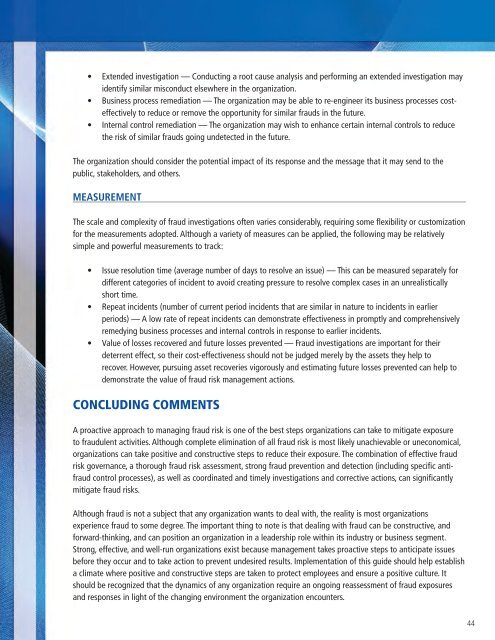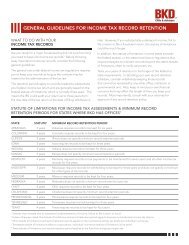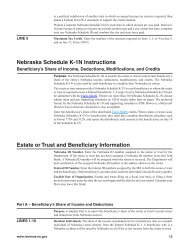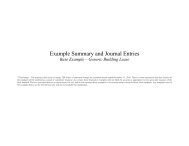The investigation team should document and track the steps of the investigation, including:• Items maintained as privileged or confidential.• Requests for documents, electronic data, and other information.• Memoranda of interviews conducted.• Analysis of documents, data, and interviews and conclusions drawn.Reporting the ResultsThe investigation team should report its findings to the party overseeing the investigation, such as seniormanagement, directors, or legal counsel. Where legal counsel is s<strong>up</strong>ervising the investigation, counsel willdetermine the appropriate form of the report. The nature and distribution of the report may be affected by thegoals of protecting legal privileges and avoiding defamatory statements. For similar reasons, advice of counselshould be sought before the party overseeing the investigation makes public statements or other communicationsregarding the investigation.Corrective ActionAfter the investigation has been completed, the organization will need to determine what action to take in responseto the findings. Any findings of actual or potential material impact may need to be reported to the board, the auditcommittee, and the external auditor if they are not receiving investigation reports directly. Notification may also berequired to legal and regulatory agencies and the organization’s insurers.In some cases it may be necessary to take certain actions before the investigation is complete (e.g., to preserveevidence, maintain confidence, or mitigate losses). This could require suspension or reassignment of individualsor legal actions to restrain assets. Those responsible for such decisions should ensure there is a sufficient basisfor those actions.Any action taken should be appropriate under the circumstances, applied consistently to all levels of employees,including senior management, and should be taken only after consultation with individuals responsible for suchdecisions. Management consultation with legal counsel is strongly recommended before taking disciplinary, civil,or criminal action.Possible actions include one or more of the following:• Criminal referral — The organization may refer the case to law enforcement voluntarily, and, in somecases, it may be required to do so. Law enforcement has access to additional information and resources thatmay aid the case. Additionally, referrals for criminal prosecution may increase the deterrent effect of theorganization’s <strong>fraud</strong> <strong>prevention</strong> policy. An appropriate member of senior management, such as thechief legal counsel, should be authorized to make the decision as to whether pursuing criminal prosecutionis appropriate.• Civil action — The organization may wish to pursue its own civil action against the perpetrators to recoverfunds.• Disciplinary action — Internal disciplinary action may include termination, suspension (with or withoutpay), demotion, or warnings.• Insurance claim — The organization may be able to pursue an insurance claim for some or all of its losses.43
• Extended investigation — Conducting a root cause analysis and performing an extended investigation mayidentify similar misconduct elsewhere in the organization.• Business process remediation — The organization may be able to re-engineer its business processes costeffectivelyto reduce or remove the opportunity for similar <strong>fraud</strong>s in the future.• Internal control remediation — The organization may wish to enhance certain internal controls to reducethe risk of similar <strong>fraud</strong>s going undetected in the future.The organization should consider the potential impact of its response and the message that it may send to thepublic, stakeholders, and others.MeasurementThe scale and complexity of <strong>fraud</strong> investigations often varies considerably, requiring some flexibility or customizationfor the measurements adopted. Although a variety of measures can be applied, the following may be relativelysimple and powerful measurements to track:• Issue resolution time (average number of days to resolve an issue) — This can be measured separately fordifferent categories of incident to avoid creating pressure to resolve complex cases in an unrealisticallyshort time.• Repeat incidents (number of current period incidents that are similar in nature to incidents in earlierperiods) — A low rate of repeat incidents can demonstrate effectiveness in promptly and comprehensivelyremedying business processes and internal controls in response to earlier incidents.• Value of losses recovered and future losses prevented — Fraud investigations are important for theirdeterrent effect, so their cost-effectiveness should not be judged merely by the assets they help torecover. However, pursuing asset recoveries vigorously and estimating future losses prevented can help todemonstrate the value of <strong>fraud</strong> risk management actions.CONCLUDING COMMENTSA proactive approach to managing <strong>fraud</strong> risk is one of the best steps organizations can take to mitigate exposureto <strong>fraud</strong>ulent activities. Although complete elimination of all <strong>fraud</strong> risk is most likely unachievable or uneconomical,organizations can take positive and constructive steps to reduce their exposure. The combination of effective <strong>fraud</strong>risk governance, a thorough <strong>fraud</strong> risk assessment, strong <strong>fraud</strong> <strong>prevention</strong> and detection (including specific anti<strong>fraud</strong>control processes), as well as coordinated and timely investigations and corrective actions, can significantlymitigate <strong>fraud</strong> risks.Although <strong>fraud</strong> is not a subject that any organization wants to deal with, the reality is most organizationsexperience <strong>fraud</strong> to some degree. The important thing to note is that dealing with <strong>fraud</strong> can be constructive, andforward-thinking, and can position an organization in a leadership role within its industry or business segment.Strong, effective, and well-run organizations exist because management takes proactive steps to anticipate issuesbefore they occur and to take action to prevent undesired results. Implementation of this guide should help establisha climate where positive and constructive steps are taken to protect employees and ensure a positive culture. Itshould be recognized that the dynamics of any organization require an ongoing reassessment of <strong>fraud</strong> exposuresand responses in light of the changing environment the organization encounters.44
- Page 1 and 2:
ACFE FRAUD PREVENTIONCHECK-UP
- Page 3 and 4:
ACFE FRAUD PREVENTIONCHECK-UPThe Be
- Page 5 and 6: ACFE FRAUD PREVENTIONCHECK-UPACFE F
- Page 7 and 8: ACFE FRAUD PREVENTIONCHECK-UPACFE F
- Page 9 and 10: ACFE FRAUD PREVENTIONCHECK-UPACFE F
- Page 11 and 12: ACFE FRAUD PREVENTIONCHECK-UPACFE F
- Page 13 and 14: Sponsored by:The Institute of Inter
- Page 15 and 16: Team Members:Toby J.F. Bishop, CPA,
- Page 17 and 18: Managing the Business Risk of Fraud
- Page 19 and 20: establish their own fraud risk mana
- Page 21 and 22: Fraud risk identification may inclu
- Page 23 and 24: Thus, to properly address fraud ris
- Page 25 and 26: The board also has the responsibili
- Page 27 and 28: • Implementing adequate internal
- Page 29 and 30: Fraud Risk Management Program Compo
- Page 31 and 32: ecently been hired in the purchasin
- Page 33 and 34: Organizations can identify and asse
- Page 35 and 36: The Risk Assessment TeamA good risk
- Page 37 and 38: This also involves understanding th
- Page 39 and 40: - Invoices for goods not received o
- Page 41 and 42: Other RisksRegulatory and Legal Mis
- Page 43 and 44: SECTION 3: FRAUD PREVENTIONPrincipl
- Page 45 and 46: An organization’s HR group is oft
- Page 47 and 48: SECTION 4: FRAUD DETECTIONPrinciple
- Page 49 and 50: Process ControlsProcess controls sp
- Page 51 and 52: keep such information confidential.
- Page 53 and 54: will vary depending on the nature,
- Page 55: Conducting the InvestigationPlannin
- Page 59 and 60: Fraud ControlsDeloitte Forensic Cen
- Page 61 and 62: APPENDIX B: SAMPLE FRAMEWORK FOR A
- Page 63 and 64: APPENDIX C: SAMPLE FRAUD POLICY 41N
- Page 65 and 66: CONFIDENTIALITYThe ______________ U
- Page 67 and 68: Sample Fraud Policy Decision Matrix
- Page 69 and 70: Identified Fraud Risksand Schemes (
- Page 71 and 72: 2) Misappropriation of:a) Tangible
- Page 73 and 74: ) Embezzlement(1) False accounting
- Page 75 and 76: Fraud Prevention Area, Factor, or C
- Page 77 and 78: Fraud Prevention Area, Factor, or C
- Page 79 and 80: Fraud Prevention Area, Factor, or C
- Page 81 and 82: Fraud Prevention Area, Factor, or C
- Page 83 and 84: O-Organization / PersonnelO1-Leader
- Page 85 and 86: O4.3 Enhance Operational Skills & C
- Page 87 and 88: PR-Prevent, Protect & PreparePR1-Ge
- Page 89 and 90: E-Periodic EvaluationE1-Evaluation
- Page 91 and 92: I2-CommunicationI2.1 Develop Commun
- Page 93 and 94: CriminologyFraud Prevention Program
- Page 95 and 96: CriminologyFraud Prevention Program
- Page 97 and 98: CriminologyFraud Prevention Program
- Page 99 and 100: CriminologyFraud Prevention Program
- Page 101 and 102: CriminologyFraud Prevention Program
- Page 103 and 104: CriminologyFraud Prevention Program
- Page 105 and 106: CriminologyFraud Prevention Program
- Page 107 and 108:
CriminologyFraud Prevention Program
- Page 109 and 110:
CriminologyFraud Prevention Program
- Page 111 and 112:
CriminologyFraud Prevention Program
- Page 113 and 114:
CriminologyFraud Prevention Program
- Page 115 and 116:
CriminologyFraud Prevention Program
- Page 117 and 118:
Sample Fraud PolicyAssociation of C
- Page 119 and 120:
Sample Fraud PolicyCONFIDENTIALITYT
- Page 121 and 122:
Sample Fraud PolicyFraud Policy Dec
- Page 123 and 124:
Fraud’s Worst Enemyhttp://www.fra
- Page 125 and 126:
ACFE Insights - ACFE Insightshttp:/
- Page 127:
ACFE Insights - ACFE Insightshttp:/









